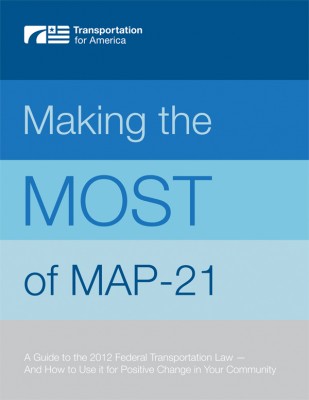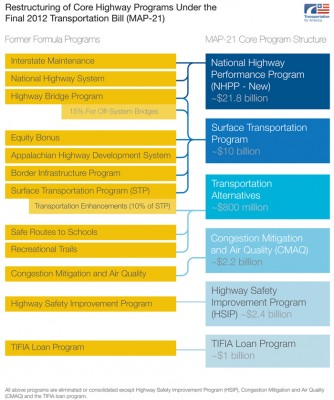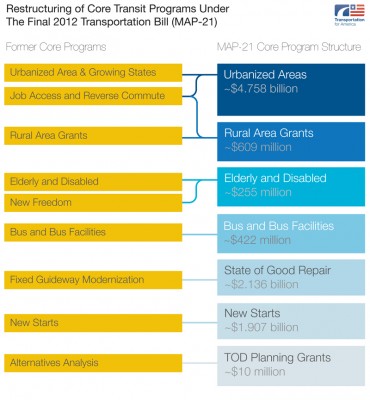A Guide to the 2012 Federal Transportation Law — And How to Use it for Positive Change in Your Community
 While federal lawmakers had considered a one-third cut in federal transportation funding, the final two-year transportation bill essentially holds spending level at $52.5 billion a year. In many ways, MAP-21 looks and feels the same as the previous transportation law, SAFETEA-LU. However, there are significant changes to many programs and the path to funding can be confusing.
While federal lawmakers had considered a one-third cut in federal transportation funding, the final two-year transportation bill essentially holds spending level at $52.5 billion a year. In many ways, MAP-21 looks and feels the same as the previous transportation law, SAFETEA-LU. However, there are significant changes to many programs and the path to funding can be confusing.
This handbook attempts to explain the many changes — positive and negative — and outline how you can help get involved and urge your state to make sure that money reflects the priorities of local communities.
Learn more and get your free copy of the 109-page handbook.
Getting started: Ten things to know about MAP-21
After digesting the 600-plus pages of the law, here are 10 key things to know about the new, two-year national transportation program. The question to keep in the back of your mind as you read is this: After two years and more than $100 billion dollars, will we have made real progress on repairing our roads and bridges, making streets safer for all, and giving more people more options to get around quickly and affordably?
Click here to read the full list with longer detailed explanations of each point.
- Incentivizing costly new construction, making repair optional.
- Steps toward accountability for performance, but few teeth.
- A false promise of “flexibility”.
- Less money, but more local control, to make streets safer for all users.
- Continued funding of transit “New Starts” projects.
- More capacity to borrow, but less to innovate.
- Transit stays in the trust fund, with more accountability for repair and safety.
- Multiple changes to environmental and citizen review, with unpredictable impact.
- For rural communities, a seat at the table and a focus on the most dangerous roads.
- Tolling for new interstate lanes and HOV sleight-of-hand, and an emphasis on public-private partnerships.
What happened to the core programs?

MAP-21 eliminated or consolidated dozens of programs and made significant changes to several others. Learn more about these changes with these short explainers on six of the core programs in MAP-21.
- Surface Transportation Program
- National Highway Performance Program (New)
- Transportation Alternatives (New)
- Highway Safety Improvement Program
- Congestion Mitigation and Air Quality
- TIFIA loan program (upgraded with funding increased)
Click to enlarge these two graphics showing how the transit and highway programs were reorganized.
Supplementary MAP-21 data and figures
These tables listed below are the appendices to the MAP-21 handbook and can be found in the back of the PDF copy. They provide the funding totals by program as well as some supplementary data points (deficient bridges, pedestrian fatalities, etc.) that can help support you over the next two years as you get involved at the state and local level in implementing MAP-21.
- Appendix A-1: Funding by program by state in dollars (NHPP, STP, and HSIP)
- Appendix A-2: Funding by program by state in dollars (CMAQ, MP, TA and totals)
- Appendix B: Bridge data by state, by NHS, other federal-aid, off-system bridges
- Appendix C: Bicycle and pedestrian deaths per year (2008-2010 average)
- Appendix D: Reduced congestion costs due to transit by region (TTI)
- Appendix F: Household transportation costs by metro region
- Appendix G: Public transportation apportionments to states (FY13)
- Appendix H: Public transportation apportionments to urbanized areas (FY13)
The road to MAP-21
You can read all of our blog posts, stories and press releases about MAP-21 dating all the way back to November 2011 by using this tagged archive.







